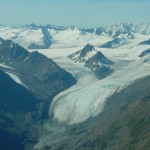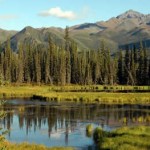A trip to the Alaskan Glaciers is on many peoples’ bucket list of things to do before they die, and Rich and I were among that group. In 2009 we had a cruise to Alaska all planned and nearly paid for as a way to celebrate our 30th wedding anniversary. But 2009 was the year of the global economic meltdown and Rich, along with many other people, was downsized out of the job that had taken us across the country five years before. In spite of whatever concerns we had about global warming shrinking the glaciers we were hoping to see, we canceled our trip, and hit the ground running to re-imagine our work lives.
 I read somewhere during that time, “the loss of a job is similar to the death of a close family member.” The impact on us of this particular meltdown seemed particularly overwhelming as we had only recently arrived at some sense of equilibrium after the illness and death of our 42 year-old daughter, Corinne.
I read somewhere during that time, “the loss of a job is similar to the death of a close family member.” The impact on us of this particular meltdown seemed particularly overwhelming as we had only recently arrived at some sense of equilibrium after the illness and death of our 42 year-old daughter, Corinne.
Now four years later, we stand on the balcony of our cabin in front of a tidewater glacier, observing its irregularly sculptured peaks and crevices, listening to the snaps, creaks, and pops of this gigantic frozen river of ice, in its constant movement towards the sea. Yes, most of the glaciers are receding, and as Alaska warms more severe colder weather events come to the lower 48 states and Europe. As the permafrost melts huge amounts of methane are released, further fueling the rate of climate change.
 We learn that after the meltdown, the land left bare beneath begins anew. Moss and lichen populate and create a covering that adds nitrogen, preparing soil for wildflowers and scrubby bushes, and finally, deciduous and evergreen trees join the dance, creating a forest.
We learn that after the meltdown, the land left bare beneath begins anew. Moss and lichen populate and create a covering that adds nitrogen, preparing soil for wildflowers and scrubby bushes, and finally, deciduous and evergreen trees join the dance, creating a forest.
Through all these changes, sea and land animals change their habitats, following their food, just as we humans relocate to find work and an environment where we, and our offspring can prosper and grow.

